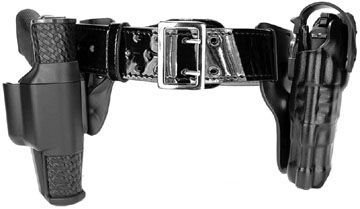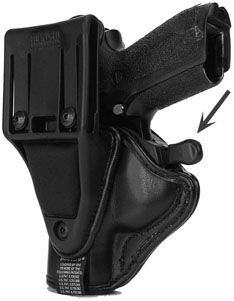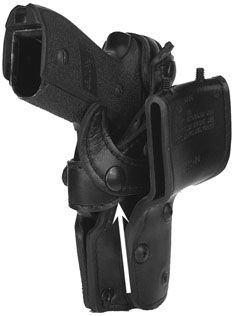
The mission of the duty holster is different from that of high-retention concealment gear, which was the subject of a previous evaluation (September 2005). As part of uniform carry, the weapon is not protected by cover. It is in the open for everyone to see. For many, the gun is seen as an extension of the badge, whether the badge says game warden, constable, security, patrolman, or other law-enforcement function.
In a series of background interviews with deputy sheriffs, corrections officers, and SWAT personnel, we learned that draw-and-retention training was the key to survival, and the mind was the ultimate weapon. Some officers said they never let anyone near them. Or, at the very least constantly monitor distance and angle of contact between themselves and those they encounter.
In any law-enforcement situation, officers place a high priority on retaining their own firearm, both to protect themselves and others. Thus, to be effective, an exterior retention holster should only allow best access to the true owner of the gun. We also learned that for the holster to perform at its highest level, it must be mounted on the proper belt suitable to the individual, the weapon, and his or her garment. To ensure proper fit, we sought out the most experienced uniform clothier we could find, Lone Star Uniform of Houston (832-237-8000, or <www.lonestaruniforms.com>). Prices shown are manufacturers suggested retail prices.
To ensure all the holsters fit a standard belt, we purchased a 2.25-inch-wide DutyMan Model 1031 Clarino-finish leather belt for $35 and went to work. Part of what we learned is that no single device or level of retention is the complete answer. In the event of a gun grab, high-retention holsters may help create the time and opportunity for an effective counterattack.
Tactical Design Labs Professional, $125
A lot of unusual holsters have come and gone but the Professional (www.Tacticaldesignlabs.com, 877-783-5227) may be here to stay. The Professional is a polymer-bodied low-ride holster that protects all but the grip portion of the frame. Inside there was a track to protect the front sight. Our holster came with the optional basketweave design. The sturdy belt loop was connected to the main body of the holster by four heavy Allen-head bolts. The design concept of this holster was to make it as difficult as possible for anyone but the wearer to access the firearm, while not making it too inconvenient to draw from. Once we snapped the pistol into the Professional, access to the weapon favored the wearer.
A vertical tube on the outside was where the trigger finger began the release to free the gun. But an additional motion was required to complete the draw. Still, we could see where the natural tendency to trap a grabbers hand alongside the holster could free the gun to the wrong person. Inside this tunnel-like area on the holster, there was room for only one trigger finger at a time, and that finger and the accompanying grip must be perfectly vertical. A perpetrator was more likely to get a broken finger than a loaded gun as a result. Thus, to most observers the Professional appeared to be an ironclad retention device.
Currently, this holster is available for most full-size and compact Glock pistols only.
Gould & Goodrich K-Force K380 Quantum, $160
The model K380 holster is part of the Quantum lineup from Gould & Goodrich of Lillington, North Carolina (<www.Gouldusa.com>, 910-893-2071). Gould & Goodrich has been producing police and concealment gear since 1980. The K380 is available in black only for most compact and full-size semi-automatic pistols with a variety of finishes, including high gloss, black weave, or smooth leather.
Our smooth-leather holster was capable of holding a Sigarms P229 with accessory rail. The mount to the belt was a heavy polymer bracket that held the body of the holster about 0.9 inch from the belt. We could adjust the cant, and the gun rode with the back edge of the grip just above the belt line. The belt slot included adjustment for different-width belts. In between the holster and the mounting bracket was a thumb-release locking device with two positions, but from the outside the K380 looked like a plain thumb-break holster. The thumb-break strap was obvious and easy to use, we thought. Dropping the gun into the holsters internal retention bracket, we heard an audible click. Release of the internal locking mechanism required two specific movements of the thumb. The most natural response to a grab attempt is to trap the hand that is trying to steal the gun with the strong hand (the hand that usually draws the weapon). But in the case of the K380, the weak hand could also prevent the gun from leaving the holster by reaching across and holding the safety latch on the release or by concentrating on controlling the perpetrators thumb. The strong hand would then be free to grapple or grab a secondary weapon.
But the more we used this holster, we found the mechanical thumb release was too easy to overcome. A shift in the thumb release was meant to lock the mechanism, but we found that the gun could be freed with a measure of incidental movement of the thumb. Access to the weapon by the wearer was very good, depending on how natural it felt placing the thumb to the inside of the holster when drawing. But we think a criminal who simply managed to get his thumb in between the holster and belt could free the gun.
Bianchi AccuMold Elite Duty Lok Model 7940, $100
The AccuMold Elite Duty Lok holster from Bianchi (<www.Bianchi-intl.com>, 800-477-8545) is a beautifully made lined synthetic leather holster that includes a lever-release trigger-guard lock and a thumb-break snap. The bracket that connects the body of the holster to the belt was padded where it would ride against the wearers side. The Elite Duty Lok is a low-ride holster with the grip of the weapon even with the belt. The belt slot accommodated different belt widths but cant was not adjustable. The gun sat straight up and down, and only a straight upward movement would allow the gun to be drawn. The internal lock activated automatically when the gun was holstered, and it did not take much practice to learn how to connect the thumb break while barely looking. The leading edge of the holster was cut away, leaving the top of slide uncovered from the rear of the ejection port. This let the shooter begin pushing the muzzle toward the target a little bit sooner. Trademarked materials included the DuraSkin outer surface, the ErgoTek pad on the mount, and the lining was called Coptex. Bianchi has been making holsters for so long even the words Auto Retention, which refers to the internal locking mechanism, were trademarked.

We found it possible to begin our draw by disengaging the thumb snap in one fluid motion. The next step was to push the lever that extended from the bottom rear of the holster inward toward the body. The ideal draw starts with obtaining a full shooting grip while the gun is still inside the holster. Unfortunately most of our staffers were unable to depress the lever and obtain a complete grip on the pistol at the same time. We found that using the longest finger, the middle digit, removed too much strength from the grip. Using the trigger finger meant having to shift the gun in the hand once it was free. In either case this was a dangerous situation, we thought.
Safariland 6280-74-131, $151
The Safariland 6280 (<www.Safariland.com>, 800-347-1200) was the simplest holster in our test, offering only two levels of security. One was the friction provided by a tension screw, and the other a strap that crossed over the rear of the slide. The body of the 6280 was a textured black polymer, and the interior was lined with matching suede. The mounting assembly, which included the belt loop, was also polymer, but it was not adjustable for cant or different belt widths. But the loops fit our 2.25-inch-wide duty belt. Our Sigarms P229 slid easily into place, and we tightened down the Allen retention screw. The Sigarms pistols, like the Glock and many other popular duty weapons, do not have a safety that locks the slide. This limited how tightly we could turn down the retention screw. We stopped when we needed only to brace the rear of the slide with our thumb to keep it from going out of battery when we holstered. The locking strap was not a thumb break but rather a loop that pivoted to the front. A notation from the manufacturer read that the mechanism needed to be kept clean and lubricated for best performance.
After testing our other holsters, we felt relaxed using this holster. Presentation from level II retention was very simple. Between the suede interior that silenced our draw and the roller inside the holster that contacted the dustcover, action was quick and convenient. Mechanically, the retention strap was the biggest obstacle to the gun grab.
Safariland 070-74-182, $173
The 070 mid-ride holster retained the pistol using an interior block that locked onto the indent of the ejection port, a strap that encircled the gun around the trigger guard, and another more traditional strap that crossed over the rear of the slide. The holster was constructed of Safari-Laminate with a basketweave finish on the holster body and a plain leather grain texture on the mounting bracket. Safari-Laminate has the advantage of a hard inner shell with an outer coating that compresses slightly for comfort against the body. As such, the mount to the belt was the most comfortable to wear of our test holsters. Two large Allen screws protruding from the top edge of the belt loop were used to secure the holster to the belt. This will permanently mark the belt. This holster was not adjustable for cant, but its natural position in relation to the belt line was slightly butt forward.
The first level of retention was the thumb-break snap, but the second and third levels of retention were not obvious. The trigger guard break was well hidden, but we found it to be simple and natural to unsnap. The ejection port lock was invisible from the outside, so even with both straps undone, the pistol was not going to come out of the holster without a rock-back motion. In terms of defending a gun grab, reattaching the thumb-break snap was not an option.
Drawing from this holster let us get a better initial grip than with the Raptor because the tab for disengaging the trigger guard lock was in a more convenient spot. As the middle finger of the strong hand took its place beneath the trigger guard, it could brush past the tab and undo the snap in one brisk motion. If you didnt know it was there, you would probably miss it. This meant that whoever has the most training and familiarity with equipment had a distinct advantage.
Safariland 6070-74-62 Raptor, $184
The 6070 holster is a level III retention holster that is more ominous looking than its brothers. So much so that it is one of the few Safariland products to be given a name, the Raptor. Its outer surface was a shiny leatherette stretched over a polymer shell that was molded to appear to have skeletal features. The interior was lined with black suede. The polymer mounting bracket was not adjustable for cant or belt size, and the grip of the gun rode slightly above the belt line.
The Raptor offered three distinct locking points at the ejection port, trigger guard, and a loop that rotated to capture the gun across the rear of the slide. To draw, we first obtained a shooting grip on the pistol and depressed the thumb tab on the inside of the retention strap. Next, we rotated the strap forward to clear the slide and return the thumb to the grip of the pistol. With the middle finger pushing on the trigger guard retention lever, we pulled the gun upward, simultaneously rotating the butt of the gun slightly to the rear to clear the lock on the ejection port. We found that the trigger guard retention lever did not cause an interruption in grip strength, as was the case with the Bianchi Duty Lok holster. If a gun grab occurred after the retention strap had been rotated out of the way, blocking access to the trigger guard lock could give the wearer enough time to reach across with the weak hand and move the retention strap back over the top of the gun. This is one advantage of the rotating strap over the thumb-break snap, which required considerable dexterity to reattach. We also found that the mechanical trigger guard lock could possibly be re-engaged on a partially dislodged weapon by simply pushing down on the gun or the hand holding on to it.

Gun Tests Recommends
• Safariland 6070-74-62 Raptor, $184. Our Pick. The wearer could easily control each of the three retention devices for maximum security.
• Safariland 070-74-182, $173. Buy It. We thought the 070 was the most comfortable holster to wear, and it afforded a classic look. Retention at the trigger guard snap was the most discreet and easiest of all to disengage. But in our opinion, the 070 finished a close second to the Raptor holster because we preferred the Raptors loop over the 070s thumb-break snap.
• Tactical Design Labs Professional, $125. Conditional Buy. The trigger-finger channel may provide an obvious clue to removing the gun, but it can also be a trap that leads to a broken finger for anyone that tries a gun grab. However, the overall bulk of this holster may be a deal breaker.
• Safariland 6280-74-131, $151. Conditional Buy. The 6280 is a simple-to-use friction holster with a rotating loop for added retention. When we wore this holster, we couldnt help but be more wary of those around us.
• Gould & Goodrich K-Force K380 Quantum, $160. Dont Buy. This is a handsome unit with a convenient draw and a couple of defensive options. But were not sure the thumb-operated release lever was discreet enough, and it might give away the holsters operation. Furthermore, we felt that this mechanical release was too large and accessible, making it possible to be disengaged by anyone with a good grip on the gun.
• Bianchi AccuMold Elite Duty Lok Model 7940, $100. Dont Buy. Despite its construction, we think the release lever is too obvious. Furthermore, we found that operating the lever interfered with obtaining a suitable shooting grip.

























